------
Special Brush Shapes for Fine Art
by Richard Bingham
Lettering Flats,
Quills, and Daggers
Brushes of these kinds are most commonly associated with
commercial work such as sign lettering and embellishing automotive paint jobs.
Nonetheless, they may have some limited utility for the fine artist who needs
to render fine detail. To be successful using all three of these brush types
you need the paint to be loose and fluid, and the surface to be dry, smooth and
"fast". A fast surface is typically dead flat and smooth. For example, an "egg shell" surface that results when a painted
surface has been leveled with fine sandpaper, or a slick surface such as an
automotive finish (or glass) would be considered fast..
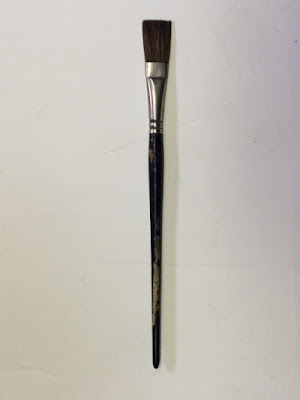 |
| A lettering flat |
The lettering flat is made from a medium-soft hair,
usually a blend of grey camel and ox hair. Their composition is the reason
these brushes are commonly referred to as "camox strokes." They come
in sizes from 1/4" to 1".
When charged or “loaded” with paint at a proper workable consistency,
lettering flats allow clean, square strokes of considerable length in one
"pull." The stroke can be varied from thick to thin by twirling the
handle in one's fingers while pulling the stroke. Unlike bristle flats, or even sable flats, lettering strokes, quills,
riggers or the dagger cannot be "back stroked" or pushed. This is because as they are loaded with paint they become too soft, limp, and heavy. They must be pulled.
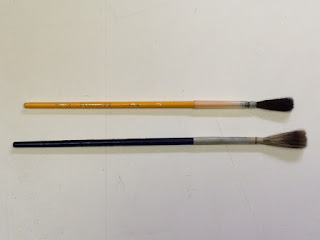 |
| Lettering quills. Note the ferrules. |
Quills gained their name because the hairs are hafted in goose quill rather than a metal ferrule. Lettering quills are made in numbered sizes from #2 to # 20. Less flexible than a flat for producing strokes with varied width, thick to thin, they are more maneuverable for makiing curving strokes of the same width. The slightly stiffer gray hair may tend to skip and "rag" the edge of the stroke. Quills come in "gray" and "brown.” The gray hairs, having a bit more "snap" than brown hairs, are easier to control, but brown hair is preferred for use over extremely "fast" surfaces, such as glass, providing a smooth, sharp-edged stroke.
 |
| Dagger striper, well-used |
------
Riggers, Ovals,
Sash Brushes, and Cutters 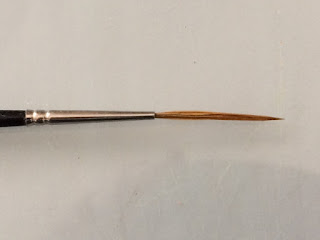 |
| Rigger |
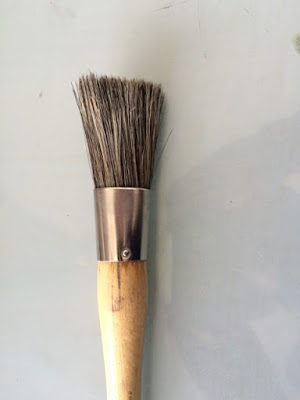 |
| Grey China oval |
House painters' ovals are another special shape that can be useful for easel painting, These can be hard to find in shops but can be had online for reasonable prices. The one shown is approximately 1 3/8"
across the long oval. Ovals are made
with gray hog bristle and are very full with hair, which makes them the perfect
brush for stippling a blend of colors that have been laid on with a flat.
Holding the short handle of the oval near its end, one "bounces" the
bristles over the previously applied wet paint working from light to dark. The
technique, properly executed, results in a seamless transition of color and/or
value without brush strokes. Depending on the nature of the paint and the
medium the paint may flow out smooth, or remain lightly "pebbled" and
non-reflective. The oval can also be used to "distress" certain kinds
of final varnish applications at the point of tack, also to minimize or
eliminate the reflectiveness of the coating.
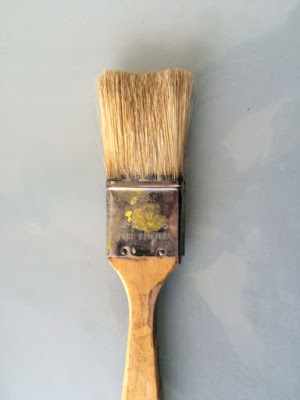 |
| Typical cutter |
White hog bristle
cutters are available in sizes from 3/4" to 3". These brushes are
called cutters because their main purpose is to make a "cut" (a
clean-edged line) with paint or varnish. An inch and a half cutter is excellent for applying
a final picture varnish, considering that the proper method for varnishing a
painting is to apply the varnish to the framed picture, being careful to
"cut" the varnish line right at the edge of the frame's rebate. It's
not a good idea to apply varnish to surfaces which will come in contact with
the frame because the varnish can adhere to the frame's rebate.
A sash brush carries a slight angle, which may be useful at the easel when control of the brush requires that one's hand not obscure the view of the work-piece. Sash brushes are used in painting or varnishing. The brush illustrated is black China hog bristle.
These brush shapes have generally been employed by sign painters, auto detail painters, and other craftsmen. While many are made with natural hair--hog bristle, camel, etc--they are also available in various synthetic fibers. They can be obtained via a number of online sources as well as in paint supply shops.
(Photo credit: Richard Bingham)
------
Brushes Part 1
Brushes Part 2
Brushes Part 3
 |
| Sash brush |
A sash brush carries a slight angle, which may be useful at the easel when control of the brush requires that one's hand not obscure the view of the work-piece. Sash brushes are used in painting or varnishing. The brush illustrated is black China hog bristle.
These brush shapes have generally been employed by sign painters, auto detail painters, and other craftsmen. While many are made with natural hair--hog bristle, camel, etc--they are also available in various synthetic fibers. They can be obtained via a number of online sources as well as in paint supply shops.
(Photo credit: Richard Bingham)
------
Brushes Part 1
Brushes Part 2
Brushes Part 3
No comments:
Post a Comment